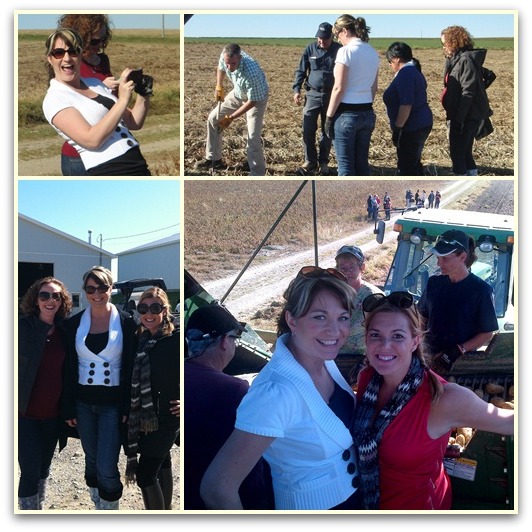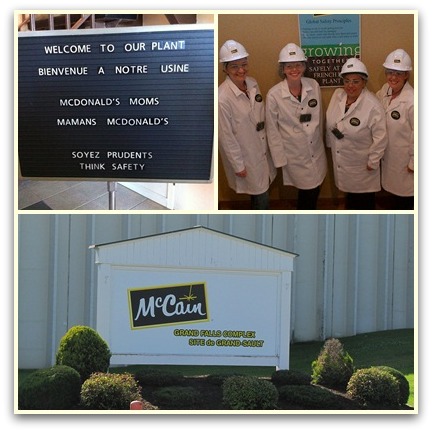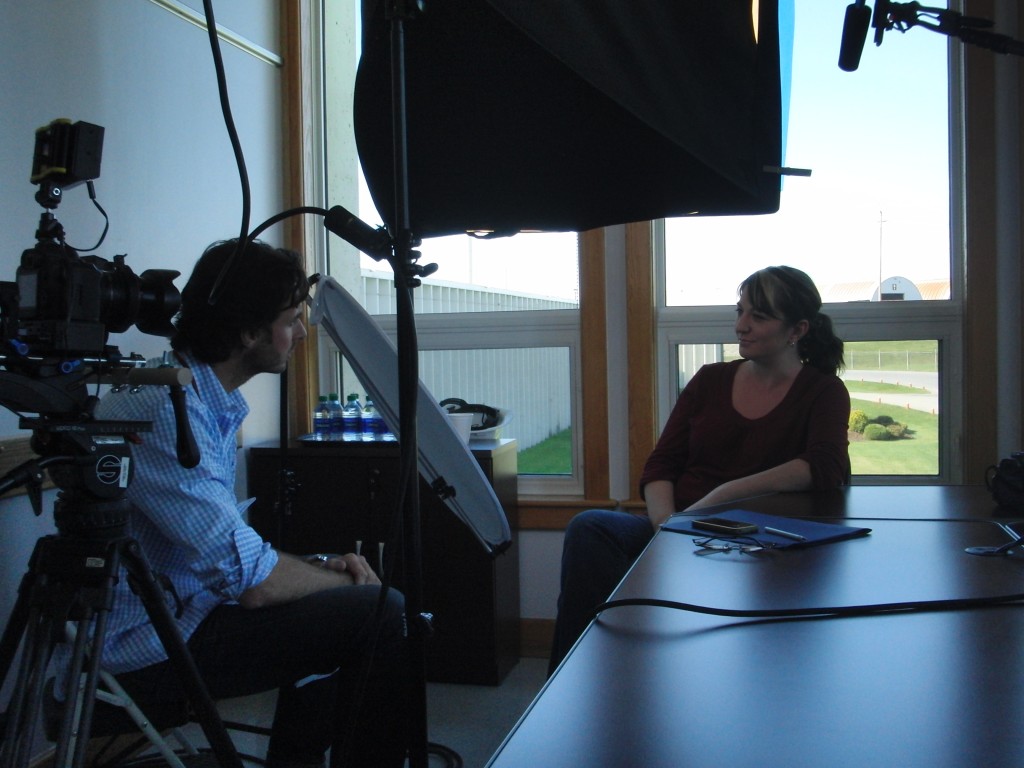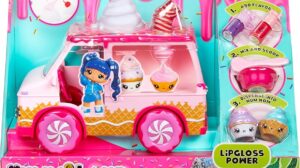When the second McDonald’s All-Access Moms trip was announced, disclosing that we – the 3 moms chosen here in Canada to partake in the program – would be traveling to New Brunswick to learn about potatoes, the reaction was likely similar for all of us. Potatoes? Seriously? How interesting could they be?
Still, this was part of my commitment to the program and I was interested to see what I could learn and take away from this trip. Of all the urban myths out there about this company, the mighty potato does not get away unscathed. There are photos on the internet showing the super-human ability of the McDonald’s French Fry to withstand disintegration. Just what are these French Fries made from, anyway? What’s in the potatoes that make these fries taste so unbelievably good? What about the growers, do they hold a sense of pride and do they enjoy working to supply McCain?
McCain is the worldwide supplier of French Fries to McDonald’s. 17 factories across the world make McDonald’s French Fries and astoundingly one in every three French fries in the world is a McCain french fry!
 Our first day in Grand Falls brought us to the Desjardins farm – a local family that has been supplying potatoes to the Grand Falls McCain facility for over ten years. We met with the husband and wife farming team (we all know the wife runs the show, right?), learned about potato planting in the spring (5-10 days in May depending on weather) and about the potato harvest in the fall which we were visiting right in the middle of.
Our first day in Grand Falls brought us to the Desjardins farm – a local family that has been supplying potatoes to the Grand Falls McCain facility for over ten years. We met with the husband and wife farming team (we all know the wife runs the show, right?), learned about potato planting in the spring (5-10 days in May depending on weather) and about the potato harvest in the fall which we were visiting right in the middle of.
The Desjardins plant 335 acres of potatoes each year, of which 180 acres are dedicated to the specific McDonald’s varieties and work with the McCain agronomy team to ensure that the potatoes grow to the right size and are free from disease or insects pests. Yes, pesticides are used, when necessary, because without such use there would be little sellable crop of the proper size and quality left at the end of the growing season.
On that note, let’s look a little deeper into the pesticide question, since it’s one that many moms including myself wonder about. Potatoes have been said to be on the dirty dozen list of the most pesticide-riddled foods, understandably so, because of the nature of the pests. While I’m aware of the dirty-dozen list, it doesn’t stop me from eating these foods though it does make me take extra precautions when preparing.
We asked McCain about the use of pesticides and were told that pesticide residue testing is done by a third party laboratory on a regular basis. These tests check for all pesticides registered for use on potatoes in Canada and if the lot tested is above the MRL (Maximum Residue Limit) it is rejected. The entire crop. Obviously this would be detrimental to the farmer so they work diligently to ensure that pesticide application is kept below the MRL. Where possible, McCain sets an even lower MRL for some applications. For example, the McCain limit for CIPC is 10 ppm which is 5 ppm lower that the Canadian MRL of 15 ppm
 On our second day visiting Grand Falls, we went on a tour of the McCain French Fry facility – yes an entire facility dedicated to making French Fry products only (the lot also held buildings where other McCain foods are prepared, making this plant a huge employer in the region). Wearing our outfits fresh off the runway (ha!), we saw the entire process start to finish on how a local farmer’s potato crop turns into a McDonald’s French Fry, bagged, boxed, and ready for shipment across Canada (all McDonald’s French Fries sold in Canada are made from Canadian potatoes, by the way!)
On our second day visiting Grand Falls, we went on a tour of the McCain French Fry facility – yes an entire facility dedicated to making French Fry products only (the lot also held buildings where other McCain foods are prepared, making this plant a huge employer in the region). Wearing our outfits fresh off the runway (ha!), we saw the entire process start to finish on how a local farmer’s potato crop turns into a McDonald’s French Fry, bagged, boxed, and ready for shipment across Canada (all McDonald’s French Fries sold in Canada are made from Canadian potatoes, by the way!)
During the tour I couldn’t help but think of one of my 7 year old’s favourite Discovery Channel shows, “How It’s Made” and how much he would love seeing something like this. The potato crop is first rinsed, a sampling of which are taken out for inspection. If more than a few potatoes do not pass inspection, the whole crop brought in could potentially be denied! The potatoes are then sent on their way through the production line which includes high pressure steam to remove the skins, blanching to deactivate enzymes that cause discoloration and remove excess sugars that result in uneven browning. Then, they’re treated with a solution of dextrose (to give the fries a golden colour after cooking), yes a sugar (if it was added for flavouring, they say they’d use sucrose, as dextrose is not as sweet) and sodium acid pyrophosphate (SAPP). They’re then par-fried in oil. Even the packaging, boxing and preparing shipments to stores was interesting to watch as everything is so precise (each bag of french fries is weighed and must be exact as well.)
I left for home after this trip taking away some positive thoughts about McDonald’s and their partnership with McCain. First, since all the french fries for McDonald’s restaurants in Canada are supplied by Canadian farmers, it made me feel really positive knowing what a huge impact that’s making on our farming industry.
Second, it was great to see the entire process from start to finish on how a potato in a field becomes a McDonald’s french fry, and see for myself that no magic ingredients were added to make this a super-french-fry. No GMO potatoes are processed at McCain (they haven’t since 2000)
So why does a McDonald’s French fry appear online in photos as having a super-human power, not appearing to mould or disintegrate as time goes by? The same holds true for the hamburger and the bun.
McDonald’s food is said to be MSG free, and I think that’s why there’s so much question and suspicion about the non-disintegrating Happy Meal. How can McDonald’s say the food is free from MSG (a flavour enhancer) yet it doesn’t appear to spoil?
The explanation the All-Access Moms have received is that it’s a moisture (water activity) issue. The buns are toasted, the meat is a thin patty that is grilled, reducing the moisture content there and the French fries are blanched, dried and par-fried at the McCain plant and then completely fried in the restaurant, reducing moisture each time. Also, the cheese is processed and won’t mould because it’s a processed food.
To a certain extent I can agree with that – it seems to make sense to me that bacteria needs moisture to grow and I’d agree that the burgers are pretty dry, a toasted bun is dry, and French fries are fried in oil sucking the moisture out of them too. I’m not shocked by any of that – I don’t kid myself into thinking a happy meal is equivalent to eating a salad in terms of nutrition or freshness.
I’d love to see some people do experiments with other food. Toast a regular hamburger bun so the cut surface is completely toasted, fry/grill or BBQ a pure beef patty (minimum internal temperature of 160F – no pink colour), and top with a processed cheese slice. Fry your frozen shoestring potatoes (they need to be the right size) at home and then leave the meal out to see what happens. My understanding is that, for the French fries at least, there may be some variation because the McDonald’s French fries are par-fried during production before cooked in a deep-fryer in the restaurant. So, there’s an extra step there, which reduces the moisture even more. As a sign that they are completely cooked, the internal texture of the French fry should be like a baked potato – not wet.
So, while the issue of a Happy Meal not appearing to mold/disintegrate is still bothersome for me, I did learn some positive things about McDonald’s and their French fry supplier, McCain. No GMO potatoes are used, pesticide levels are strictly monitored and in some instances, even lower than MRL government standards, and the entire process is there to ensure customers get the best tasting French fries in their meals.
Overall this trip was a great experience – when else would I find myself on a potato farm, riding on a harvester, checking out a production facility like McCain and meeting the people at McCain who are so passionate about their work, their brand, and their product?

In my Q&A interview at the end of the two-day tour, I shared how impressed I was with the McCain/McDonald’s partnership. I already bring my kids to McDonald’s to enjoy my favourite French fry out there, so the tour didn’t have to work to convince me to try them out. If anything, it made me feel more positive about both companies as a whole.
Keep an eye on CityTV this fall and winter for commercial spots showcasing our experience, our Q&A clips and more. Nanny Robina will be on CityLine throughout the fall and winter as well, sharing longer video clips and more info about our experiences on the trip, all of which will be also uploaded to the All Access Moms site as well!






Tenille,
That looks like a lot of fun.
I still remember from SuperSize Me the scene at the end where the fries and burger are still OK.
Interesting explanation with the pan-friend.
Is there a part 3?
Thanks!
There’s a Part 3 (Cargill Beef Facility where all the hamburgers in Canada are made for McDonald’s) which I just finished writing and am waiting to post and a Part 4 (Cargill Chicken Facility) which is the next tour I’m going on this month!
I am curious to hear what you have to say about the chicken nugget….
I learned a little when speaking with Chef Dan in Chicago this summer, but I’m curious to learn more too. (http://feistyfrugalandfabulous.com/2011/08/mcdonalds-moms/)
I love macdonalds fries — the best I’ve ever had!
I love that show how it’s made – how fun that you got to see the french fries being made. also, very interesting about the pesticides – I wonder if McDonalds is doing an American tour like this??
I’ve worked on potato harvesters before, in that area. It’s actually a rather fun job, but hard on the back! I’m happy to hear an explanation to the happy meal that didn’t mold. I love cheeseburger happy meals lol 🙂
it’s good to see the great working conditions and practices but I still can’t bring myself to eat there. The most we’ve have over the last 7 years is a breakfast sandwich.
Looks like you had a great time! McDonalds have always been my favorite fries and I never knew they were made by McCain. Those are the only kind I’ll buy in the grocery store!
WOW! I love McDonalds fries. To me, they are the only ones that really taste like potatoes. Great info, thanks!
My favorite fast food fries are McDonalds. I would have been interested in finding out what they were made from too. Looks like you had a fun time.
The best fries…
How interesting! It was fun to hear the story behind the french fries at McDonald’s. I am anxiously awaiting your post about Cargill’s!
You guys look like you had so much fun together.
What a great review… I’ll be honest If McDonald’s assures me how wonderful the products are… I’m still a little uneasy- but I believe you! LOL
It is good to know that french fries for McDonald’s restaurants in Canada are supplied by Canadian farmers…
Yum, yum, fries! Seriously a neat adventure you are on!
love their fries too!…how neat you got to do a tour…i wish they had something like that here i would go!
I had no idea that it’s McCain’s potato! Very surprised! I never liked McCain fries from the store, but absolutely love it at McDonald’s – that’s the best item on their menu ever!
what a great adventure you had… i am curios to see how your next mcdonalds trips go
McCain’s!! I never knew!! I thought they had their own secret process.
mm craving mcdonalds french fries right now! its my #1 craving cuz i’m preggers!
I was just wondering if they had ever thought of going to whole wheat buns, or at least have the option. Did they talk about this at all when you were at the McDonalds University?
Thanks
Yes, we asked about whole wheat buns! What it comes down to is, the majority of customers don’t want it. They have tried various things in test markets (veggie burgers, whole wheat buns, carrots in happy meals instead of apple slices) and the response told them that it wasn’t something that would sell well. Interesting, huh?
Check out all our posts here (the 3 McD Moms): http://allaccessmoms.cityline.ca/all-access-moms-blog/ Jill Amery from UrbanMommies writes about the whole wheat buns question in her Trip #1 post there as well.
I love McDonalds french fries! What a neat experience.
I really like the explanation about the moisture that doesn’t spoil foods….makes a lot of sense to me.
I love McDonald’s french fries!
The best fries!! Love Mickey d’s!
Love that the Canadian fries are grown right here. Mc D’s fries are my one guilty pleasure. That won’t be changing.
I sent Tobei to McDonalds many times when I was pregnant to get me fries. It is the only thing I will eat from there.
IT looks like such an amazing opportunity to have been able to go behind the scenes and see where the food at McDonalds comes from! Very interesting indeed!
I RARELY ever eat fast food, but can NEVER turn down a frie from McDonalds 🙂
Awesome trip! Looked like fun!1
What a great opportunity! I LOVE their fries too!
Now you’ve got me craving a Jalapeno McChicken with fries! 😀
I dont care what anyone says, I love me some McDonalds!! I am so jealous you got be an All-Access Mom! I wish I knew about it and was invited 🙁
Great article. It’s interesting to learn how these delicious french fries are made. They are actually the only thing (besides the fish filet) that I will eat at McDonalds.
Thanks for the info.
Very interesting to see what goes into making their french fries. Sounds like you had a lot of fun. 🙂
McDonalds is my guilty pleasure. I love it!!! Especially when we have a movie night at home!!!
mcdonalds definately has the best french fries! thanks for all the info!
polly~.
I love that McDonalds is opening up and showing people how their food is made and what is in it. We don’t eat there very much but it feels better to know for the few times we do stop there.
I love that they keep the pesticide level low. This is one thing that scares me about feeding it to my family, although we occasionally endulge.
Interesting article and makes me feel less guilty serving chicken fingers and fries.LOL Thanks for such an informative article!
Thanks for the informative article! The tour sounded very fun.
hi, this is aline from the potato farm you visited in sept… thank you for the nice comments on your blog… my husband found it funny but true about the comments am the boss…..lol….just wanted to wish you and your family merrry christmas from our family… it was nice meeting all you access mom ….. thanks
Hi Aline!! Thank you so much for your comments, you made my day! Wishing you and your family and beautiful grandchildren a happy holiday – I’m sure you’re already baking up a storm!
Wrap it in gauze and put it in the infected area. This will
ensure that you treat the right disease when you take the medication.
Get the answers you’re looking for.